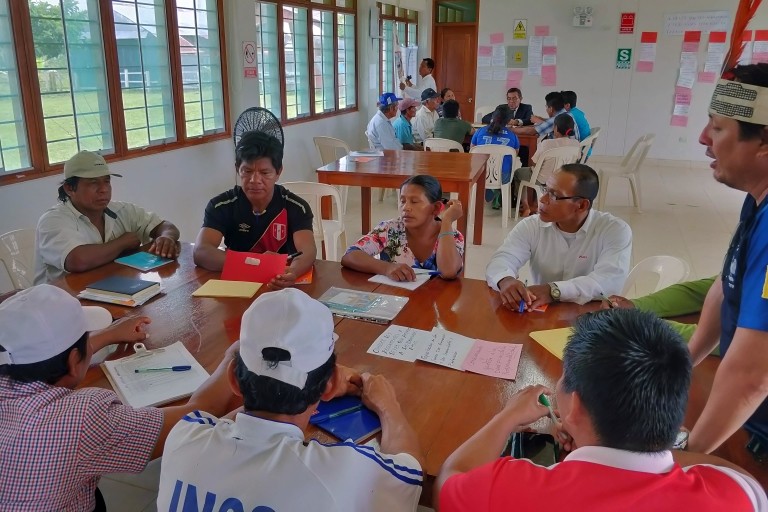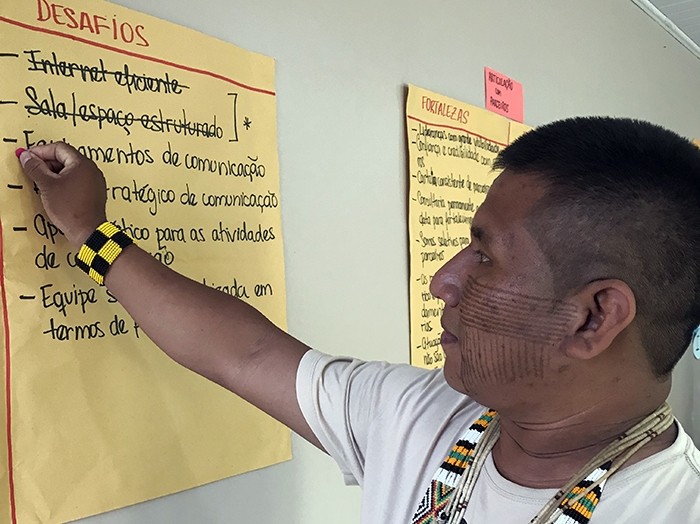Blog
Raising the voices of indigenous organizations across the Amazon region

“Indigenous women need autonomy, a voice and a light.”
This is how Telma Taurepang describes the challenges that her community has long faced. She serves as coordinator for União das Mulheres Indígenas da Amazônia Brasileira, or UMIAB, an indigenous peoples organization in Brazil.
Indeed, threats to the human rights of indigenous peoples and the organizations that represent their interests are as real as it gets. These include threats to their self-determined sustainable development, largely caused by urban growth, infrastructure and extractives projects such as gold and diamond mining, illegal logging, land grabbing, and limited ability to advocate before national governments. Now Covid-19 has added new challenges for indigenous communities that have been historically challenged by limited access to essential social services.
Yet today, Taurepang says, her organization is working to meet these challenges with help from national and international partners. UMIAB, which advocates for the rights of indigenous women, is one of ten indigenous peoples organizations across the Amazon region that Pact and USAID are supporting through an effort known as SCIOA, or Strengthening the Capacity of Indigenous Organizations in the Amazon. The project works across Colombia, Peru, Brazil, Suriname and Guyana to give local indigenous organizations the knowledge, skills and resources they need to effectively take ownership of their own development planning and priorities in a sustainable manner.
SCIOA relies on Pact’s signature, proven capacity development tools that have helped local organizations around the world improve their performance to better meet their missions and serve local communities.
Pact began this effort by conducting Applied Political Economy Analyses to better understand dynamics at play in countries across the Amazon region. With those results, Pact and its local partners selected ten indigenous organizations and began working to strengthen them.
Pact applied its Integrated Technical Organizational Capacity Assessment with each organization. These assessments help organizations understand their strengths and weaknesses and develop customized institutional strengthening plans. With training and mentorship, the organizations are now systematically improving their capacity to manage financial resources and take ownership of their own development planning and priorities. They are putting their knowledge into practice with small grants from Pact and USAID that are allowing them to apply their new capabilities to pursue concrete actions to protect indigenous community rights and mitigate impacts of extractive or infrastructure industries.
In Colombia and Peru, for example, indigenous organizations are using their grants to develop draft Life Plans – policy documents that help indigenous communities makes their own decisions regarding the future of their land and their resources, promoting autonomy and survival. Other organizations in Peru are conducting trainings on legal defense to defend the territorial rights of native communities that are experiencing land invasions and other threats. An organization in Brazil has launched an initiative to build involvement among youth in the indigenous movement and develop their leadership skills.
With a social inclusion strategy and continuous input from indigenous organizations, SCIOA is taking an adaptive approach. The project seeks to create networks at various levels, from indigenous local organizations to national civil society organizations, to protect the rights of communities in their territories.
So far, our local partners have told us their experience with SCIOA has been a positive one, with participants highlighting the ease with which they have understood the process and the ownership they have felt throughout.
“Institutional strengthening means working hard to disseminate the policies and rights of indigenous peoples. With that, we are expanding the dialogue regarding indigenous lands to defend the rights of indigenous peoples in the Madeira River region,” said Nilcélio Jiahui, with the Brazilian organization Organização dos Povos Indígenas do Alto Madeira.

“We were able to look at areas of importance that can help us in the execution of day-to-day management,” said Learmond Emmanuel, treasurer of the Moruca District Council, an indigenous group in Guyana. “We looked at governance, financial management, partnership building, human resource management, promoting and preserving traditional customs and culture, legal support, advocacy, project management, and communication and information sharing. We understand how we now have to work toward putting structures and policies in place for good governance and institutional strengthening. All of this will help to empower us.”
SCIOA’s hope is for a future in which all indigenous communities enjoy self-determined development, not only because this is their right, but because their capacities and governance are so strengthened that any other way becomes impossible.